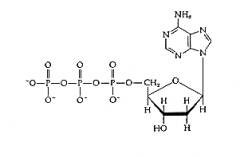|
|
97' SBIOA Exam
|
||
| 93
Exam Part A: M/C Part B: Short Answers Part C: Essay Question 94 Exam 95
Exam 97
Exam
|
PART A:
Multiple Choice. Answer
all these. One Mark each
for 39 questions, then two marks each for the next 8.
Total: 39+16 = 55
(est. time: 1 hour) Note:
I have used the terms NADH and NADH2 and NADH/H+
interchangeably (i.e., they are all meant to be equal in meaning. So
don’t look for tricks there. Also,
if I haven’t subscripted or superscripted stuff, don’t get hung up
on that either. Page
1 Page
2 Page
3 Page 4 21. Pyruvate is a charged and polar molecule. There is a lot of pyruvate in the cytoplasm, and not so as much in the mitochondrion. Which statement best describes the transport of pyruvate across the membrane: a) faciltated trasnport b) diffusion c) osmosis d) passive transport e) aactive transport 22. A scientist who worked on a single-celled green plant (an alga) treated it with enough ultraviolet light to destroy it’s genetic material just enough to produce mutant cells that did not contain chloroplasts. All other genes worked fine. To keep these cells alive, the scientist had to: a) provide them with high light intensity. b) keep them in the dark. c) provide them with a sugar solution. d) give them chlorophyll. e) increase the temperature. 23. Which of the following statements about Mendelian genetics is TRUE? a) Alternate forms of alleles are called genes. b) A locus is a gene's location on its chromosome. c) There are only two alleles for any gene. d) If you look really close at the DNA of an organism with an electron microscope , you can see letters such AaBB and A+ and B-. e) Offspring have twice the genetic material as the parents. 24. Gas exchange in cells always involves: a) cellular respiration. b) photosynthesis. c) facilitated diffusion of CO2. d) diffusion across membranes. e) active transport of gases. 25. The functional group written as -COOH is called the: a) hydroxyl group. b) carbonyl group. c) amino group. d) ketone group. e) carboxyl group. 26. Which of the following is a redox reaction? a) O2 + 4 H+ + 4 e- ± 2 H2O b) H2 ± 2 H+ + 2 e- c) H2 + O2 ± 2 H2O d) Na ± Na+ + e- e) Cl2 + 2 e- ± 2 Cl 27. The chemical structure shown below is:
a) a ribo-sugar. b) ATP c) ADP d) NADH e) NADPH 28. The reaction, “glucose + 2 ADP + 2 Pi + 2 NAD+ ± 2 pyruvate + 2 ATP + 2 NADH + 2 H+ + 2 H2O” represents: a) cellular respiration. b) the citric acid cycle. c) pyruvate oxidation. d) glycolysis. e) substrate-level phosphorylation. 29. The enzymes of the citric acid (Krebs) cycle are located in the: a) cytoplasm. b) cristae of the mitochondrion. c) matrix of the mitochondrion. d) endoplasmic reticulum. e) lysosome. 30. The two strands of the DNA double helix are held together by: a) hydrogen bonds. b) C=C double bonds. c) hydrophobic bonds. d) peptide bonds. e) covalent bonds.
<-Page 2 --- Page 3 --- Page 4->
|

